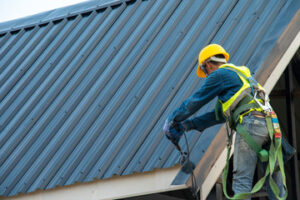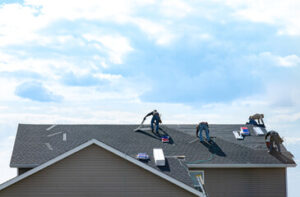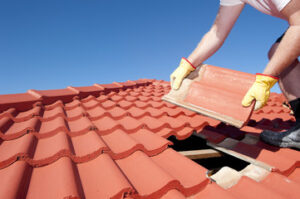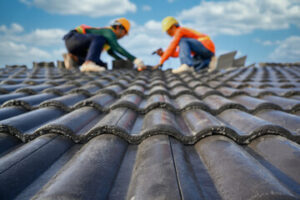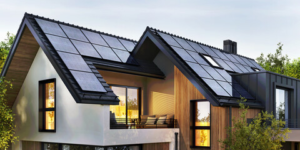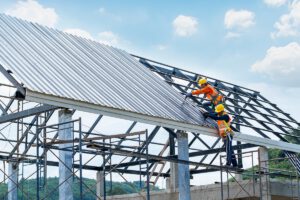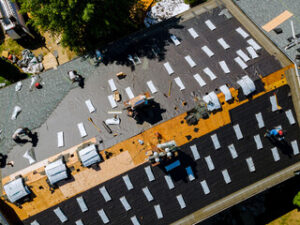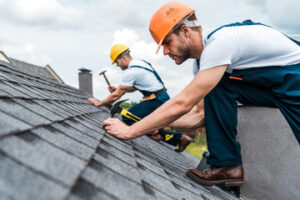The roof is an important part of the building envelope. It protects against rain, snow, sunlight, and extreme temperatures.
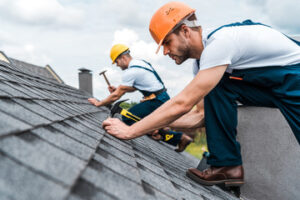
Roofing works can make a mess, so prepare your home by moving movable items indoors and covering outdoor furnishings with tarps. It’s also wise to move pets inside and have a plan for carbon monoxide leak detection. Visit https://www.fresnoroofingexperts.com/ to learn more.
During a roof tear off, your roofing contractor takes the old shingles and components off of your roof. This process is essential to finding any hidden damage to your roof deck, which will be repaired before a new layer of shingles is installed. It also provides a blank canvas for the new roofing materials.
Your roofing professionals will need access to your entire house from all sides. This means that outdoor toys, furniture and other objects will need to be moved or covered with tarps. Clearing the area can help prevent a mess and save you time from moving everything back later.
As some crew members continue to tear off sections of your roof, the others will work on preparing the area for the new roofing material. This includes removing old underlayment and sheathing, installing new plywood or ice and water shield, repairing any damaged areas of the roof deck and adding a new layer of underlayment.
It is also important for the roofers to prepare the ground outside of your home. Covering plants, flowers and other fragile areas with tarps can greatly reduce cleanup time and protect the landscaping from nails. It is also a good idea to put down plywood over air conditioners and other equipment to keep it safe from falling debris.
The roofing contractor may also need to strip off existing flashing or replace it. This is especially important for eaves, valleys and roof edges. Flashing is also needed around chimneys, skylights, dormers and exterior walls and in certain other leak-prone areas of the roof.
Underlayment
There are a variety of different roofing underlayment materials to choose from. Each type is designed for specific purposes, but all offer the same goal of preventing water infiltration. This is essential for protecting your roof deck from the damage that can lead to rot, mold, mildew and other problems. Additionally, it helps to provide a smoother surface for the shingles to be installed on and provides an additional barrier between your home and the elements.
There are three main types of underlayment: felt, synthetic, and rubberized asphalt. Felt underlayment is the most economical option. It offers superior acoustic properties and is highly moisture-resistant, making it ideal for colder climates. Synthetic underlayment, on the other hand, is lightweight and offers a waterproof membrane. It also comes in larger rolls, allowing installers to cover more area with less work. Regardless of which underlayment product you choose, it’s crucial to ensure that your roofers adhere to local building codes. These rules might have specifications for wind resistance, fire resistance and other factors that impact the underlayment’s performance.
For those looking for an underlayment with even more protection, consider rubberized asphalt. This is one of the toughest underlayment products available, boasting up to 12 times more strength than No. 30 asphalt felt and an excellent tear-resistance rating. However, this underlayment isn’t fully waterproof and can only withstand up to three months of UV exposure. Fortunately, there are many other options that can withstand up to a year of UV exposure. These include ProArmor, TigerPaw and Tyvek 120. They all offer a slip-resistant walking service and are inert to mold growth. They’re also compatible with a variety of roof materials, including metal and shingle.
Shingles
After the underlayment is in place, you can begin laying the shingles. Ensure the first course of shingles is nailed down directly on top of the underlayment using four nails per shingle or as recommended by the manufacturer (six nails for high-wind areas). Begin laying shingles from the left eave edge and work right to the ridge, overlapping each row with the previous one. After completing this first course of shingles, snap horizontal chalk lines up the roof to ensure each row is straight.
It’s important that each shingle is aligned properly and securely, especially in areas that are more vulnerable to leaks. If a shingle isn’t properly placed, water can seep down between the underlayment and shingle, compromising the structural integrity of the roof and the lifespan of the shingles.
When installing shingles, be sure to choose ones with a warranty that meets your needs. Longer warranties are typically more expensive, but may provide additional peace of mind for homeowners.
Installing a new roof can be quite a noisy process, especially when scrapping away the old shingles and metal sheets. If you have children or pets who are sensitive to noises, it’s a good idea to relocate them during the project.
Installing a ridge cap is another crucial step that helps prevent leaks and protect the underlayment. There are special shingles designed to cover the peak of your roof, and they should be installed with shingle tabs facing each other so that water, snow and debris can exit the roof without leaking in between the two peaks. Installing flashing around chimneys, vents and skylights is also necessary to help prevent water infiltration.
Flashing
Flashing is the thin strip of weather-resistant material that’s installed at roof intersections and projections, including chimneys, vent pipes, skylights, and windows. It serves to seal vulnerable areas and prevent leaks that could otherwise cause severe water damage in the home.
Roof flashing is made from a durable metal, such as galvanized steel (a zinc coating) or aluminum. This material is bent into place and sealed with caulking or another waterproof sealant to create a watertight barrier around the vulnerable area. The flashing is also installed to help direct water flow from the roofing surface out through the gutter system or away from the structure’s foundation.
There are several different types of flashing, but the most common is step flashing. This type of flashing is used where two downward slopes of the roof meet, like at a valley, or where the roof meets a wall. The flashing is then covered with a layer of shingles, to protect it from the elements.
Other types of flashing include drip edge and counter flashing. Drip edge flashing is placed at the edges of the roof and helps to guide water away from fascia boards and other structural components. It’s important that this flashing is properly installed, as it’s a key safeguard against moisture-related problems.
Counter flashing is usually used alongside chimneys in new construction or roof replacement projects. It’s placed over the top of a piece of base flashing to ensure that rainwater doesn’t slip behind it and cause damage to the roofing materials. This is one of the most critical areas of the roof and should only be done by a licensed professional. When installed improperly, it can leave the roof open to severe water infiltration.
Insulation
Insulation is a key aspect of roof installation. It helps maintain a comfortable temperature throughout the year and improves energy efficiency, saving homeowners on utility bills. Proper insulation also prevents water leaks from causing damage to the house.
There are several different types of insulation available, and the right choice depends on a home’s structure and energy requirements. Foam board insulation, for example, is a popular option because it’s easy to install and offers a high R-value. It also resists moisture and pests. There are many variations of foam board insulation, including extruded polystyrene (XPS), expanded polystyrene (EPS), and polyisocyanurate (Polyiso). Each type of insulation has its own unique advantages and disadvantages.
Other types of insulation include batt blankets, fiberglass, and cellulose. Each of these types has its own unique advantages and disadvantages, and the best choice depends on the needs of the homeowner. For example, fiberglass is inexpensive and easy to install, but it’s not as effective as other insulation options.
Spray foam insulation is another great option because it’s durable and provides a higher R-value than other types of insulation. It also seals better and doesn’t shrink over time, which makes it a good choice for attic floors that will be used for living space.
Loose-fill or blown-in insulation is also a viable option. This insulation is sold in bags and consists of loose fibers, which can be shaped to fit any gap. It’s also fire-resistant and mold-resistant, making it a good choice for attics with exposed wood framing. However, it’s important to remember that over-insulation can cause heat to build up under the shingles and shorten their life span. Therefore, it’s best to consult a professional when choosing and installing this type of insulation.
